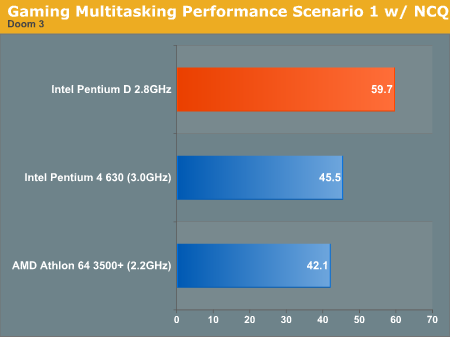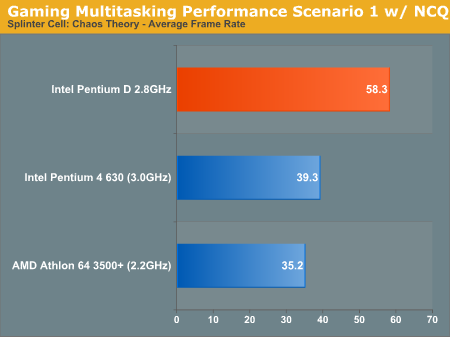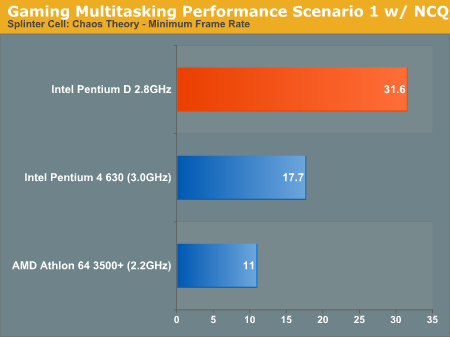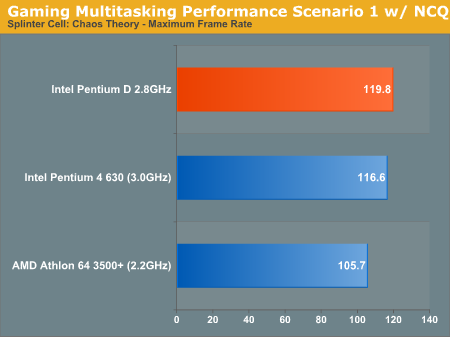Intel Dual Core Performance Preview Part II: A Deeper Look
by Anand Lal Shimpi on April 6, 2005 12:23 PM EST- Posted in
- CPUs
Gaming Multitasking Scenario 1 w/ NCQ
We noticed that many of the pauses during GMT1 were disk related, so I tried using the 7200.7 drive with NCQ support. The difference was very perceivable. The number of stalls was reduced significantly as is evidenced by the increase in average frame rates.




On the Pentium D, we saw the largest increase in performance while playing Splinter Cell; the game never stalled, not even once.
GMT1 with NCQ wasn't nearly as successful on the Pentium 4 630. The game was still way too choppy for regular gameplay.










106 Comments
View All Comments
BoBOh - Monday, April 11, 2005 - link
Where are the code compile tests. We're not all gamers, some are software developers! :)BoB
NightCrawler - Saturday, April 9, 2005 - link
Dual core Athlon 64's in June ?fitten - Saturday, April 9, 2005 - link
- also, there should be (SMT) after simultaneous multi-threading in the quote from the paper on the IBM site.fitten - Saturday, April 9, 2005 - link
- quote should be in front of "Scalable not after.fitten - Saturday, April 9, 2005 - link
a) By definition, Intel's implementation must be different than IBM's or anyone elses' because the CPUs aren't implemented the same. Not only do they implement different ISAs, but the entire architectures are different... different number of registers, different ISA, different designs.2) Intel's definition of HyperThreading: http://www.intel.com/technology/hyperthread/
D) This paper http://domino.watson.ibm.com/acas/w3www_acas.nsf/i...$FILE/heinrich.pdf , found on IBM's site by searching, is entitled Scalable "Multi-threaded Multiprocessor Architectures". The first paragraph states: "The former [hardware multi-threading], in the form of hyper-threading (HT) or simultaneous multi-threading, appears in the Intel Xeon and Pentium 4, and the IBM POWER5."
Reflex - Friday, April 8, 2005 - link
Well first off, I am not going to do everyone's homework on this, the info is out there, you all have Google. If you ask a IBM engineer if what Intel is doing is the same as what they are doing, or even if it is really SMT, they would tell you flat out that it is not and they fullfill completely different needs in their products and are implemented completely different. Your definition seems to be that the hardware can accept two threads, therefore it is SMT. That is a VERY simplisitic definition of what SMT is, when there are actually many variations on the concept(HT is a variation, but it is not what most CPU engineers consider actual SMT).One of the primary issues here is that HT does not actually allow two simultanious threads, it is more of a enhanced thread scheduler that attempts to fill unused units with jobs that are pending. A true SMT CPU is actually architecturally able to execute two simultanious threads, its not just filling in idle parts of the pipeline with something to do(highly parallel designs). There is a ton of info on this, if you care I suggest you do the research yourself, I don't have the time(and in some ways the expertise) to write a lengthy article on the topic.
Alternatly, you can just buy into the marketing I suppose, its no skin off my teeth.
fitten - Friday, April 8, 2005 - link
I was going to comment on the phrase "true SMT" above. I'm wondering if this comes from the same lines of thought as the "true dual-core" arguments.Anyway, "HyperThreading" (HT) is just Intel marketing terminology for Symmetric MultiThreading (SMT). They are one and the same, with the same design goals... to more effectively utilize core resources by keeping the resources more busy instead of sitting around idle, particularly at the time granularity of cache misses and/or latencies.
defter - Friday, April 8, 2005 - link
#93 "Intel has labeled it as SMT, however there is another name for what they are doing(that I cannot remember at the moment). What they are calling SMT is nowhere even close to solutions like Power."Well please tell us the exact definition of SMT and the difference between the multithreading in Power and P4?
"That aside, the implementation Intel has chosen is designed to make up for inefficiencies in the Prescott pipeline"
In Prescott pipeline? Why did the HT exist in Northwood based Xeons then? Of course the SMT is designed to reduce inefficiencies in the pipeline. If the CPU can utilize most of its resources when running a single thread there isn't a point of implementing SMT.
saratoga - Friday, April 8, 2005 - link
#93: Intel labeled SMT Hyperthreading. It is effectively the same as what the newer Power processors do (make one core two threads wide).It also was not designed for Prescott, rather it was included in the P7 core from the beginning. For this reason it was available on P4s prior to Prescott.
saratoga - Friday, April 8, 2005 - link
#80:HT improves the utilization of execution resources. Its not a bandaid, its a design choice. In some cases it can be used to compensate for some other weakness, in others it can simply be to increase throughput on multithreaded workloads.
Sun and IBM use it because they build server systems and SMT makes a large difference in traditional server loads.
Intel uses it because they realized it would work well with the P4. I don't know why AMD does not use it. Probably because they don't think the Athlon has enough unused hardware on typical loads to justify the extra transistors. Or maybe just because the Athlon was not designed with it in mind and they can't justify redoing the whole thing to add a single feature. Or maybe a combination of the two.